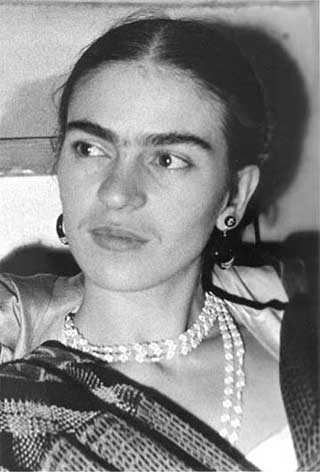
Frida Kahlo (1907 – 1954), born Magdalena Carmen Frida Kahlo y Calderón, was a popular Mexican painter. She painted using vibrant colors in a style that was influenced by the indigenous cultures of Mexico. Many of her works are self-portraits that symbolically expressed her own pain. Kahlo was married to Mexican muralist Diego Rivera.
Her Jewish Hungarian-German father arrived in Mexico in 1891 and married Frida's mother, a devout Catholic of indigenous and Spanish descent.
Kahlo contracted polio at six, which left her right leg thinner than the left, a fact that Kahlo disguised by wearing long, colorful skirts. Some believe that she also suffered from spina bifida.
In 1925, Kahlo was riding in a bus when it collided with a trolley car. She suffered serious injuries in the accident, breaking her spinal column, collarbone, ribs, pelvis, leg, and foot. An iron handrail pierced her abdomen, causing permanent injury to her reproductive organs.
While Kahlo was bedridden during her recovery, she began to paint.
Although she recovered from her injuries and eventually regained her ability to walk, she suffered extreme pain throughout the rest of her life.
This constant pain informed Kahlo's artwork, and was frequently portrayed symbolically in her paintings.
Middle school students and older can understand the themes in Kahlo's self-portraits.
Project idea: Look at and discuss selected examples of Kahlo's self-portraits, including Self-Portrait with Monkeys, 1940. Use multi-cultural construction paper to cut out the head and shoulders for a self-portrait. Add hair and clothing. Cut large construction paper leaves to fill in the background. Students may add other details to their portrait to represent their lives, such as pets or symbols of their interests.
Source for biographical information: Wikipedia
Her Jewish Hungarian-German father arrived in Mexico in 1891 and married Frida's mother, a devout Catholic of indigenous and Spanish descent.
Kahlo contracted polio at six, which left her right leg thinner than the left, a fact that Kahlo disguised by wearing long, colorful skirts. Some believe that she also suffered from spina bifida.
In 1925, Kahlo was riding in a bus when it collided with a trolley car. She suffered serious injuries in the accident, breaking her spinal column, collarbone, ribs, pelvis, leg, and foot. An iron handrail pierced her abdomen, causing permanent injury to her reproductive organs.
While Kahlo was bedridden during her recovery, she began to paint.
Although she recovered from her injuries and eventually regained her ability to walk, she suffered extreme pain throughout the rest of her life.
This constant pain informed Kahlo's artwork, and was frequently portrayed symbolically in her paintings.
Middle school students and older can understand the themes in Kahlo's self-portraits.
Project idea: Look at and discuss selected examples of Kahlo's self-portraits, including Self-Portrait with Monkeys, 1940. Use multi-cultural construction paper to cut out the head and shoulders for a self-portrait. Add hair and clothing. Cut large construction paper leaves to fill in the background. Students may add other details to their portrait to represent their lives, such as pets or symbols of their interests.
Source for biographical information: Wikipedia




No comments:
Post a Comment